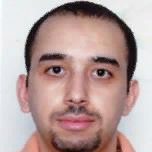
Khalid SABRI
Work place: STIC laboratory, Faculty of sciences, University Chouaïb Doukkali, El Jadida, Morocco
E-mail: sabri.k@ucd.ac.ma
Website:
Research Interests: Computer Science & Information Technology
Biography
Khalid SABRI was born in Rabat, Morocco on October 28th1979. He received the B. S. degree in informatic, electronic, electrotechnic and automatic in 2002 and the M.S. degree in informatic and telecommunications from Université Mohammed V-Agdal, Rabat, Morocco in 2004, and the Ph.D. degree, in Signal Processing, in September 2008, jointly form Université Jean Monnet, Saint-Etienne, France and Université Mohammed VAgdal, Rabat, Morocco. From September 2008 to December 2008, he had a post-doc position at Laboratoire d'analyse des signaux et des processus industriels, Université Jean Monnet, Saint-Etienne, France. From January 2009 to December 2010, he had a post-doc position at Institut de Recherche en Astrophysique et Planétologie, Observatoire MidiPyrénées, Toulouse, France. Since 2011, he has been an associate professor at Université Chouaïb Doukkali, El Jadida, Morocco. His research interests are in the areas of blind source separation, Sparse deconvolution, Cyclostationarity
Author Articles
Cyclic Analysis of Extra Heart Sounds: Gauss Kernel based Model
DOI: https://doi.org/10.5815/ijigsp.2018.05.01, Pub. Date: 8 May 2018
Phonocardiograms (PCG) Phonocardiograms (PCG) are recordings of the acoustic waves produced by the mechanical action of the cardiac system. This makes PCG an effective method for tracking the progress of heart diseases. A PCG signal, in the healthy case, consists of two fundamental sounds s1 and s2. These two elements are derived from the mechanical functioning of the heart. A triple rhythm in diastole is called a gallop and results from the presence of a heart sound s3, s4 or both. An Extra Heart Sound (EHS) may not be a sign of disease. However, in some situations it is an important sign of disease, which, if detected early, could save lives. The major aim of this study is to propose cyclostationary and Gabor kernel based mathematical model for extra heart sounds. The ambition behind it is to present a framework, making use of cyclic statistics for robustness to low SNR conditions, which allow the detection of EHS s3 and s4 and hence the early identification of some heart diseases. For this reason, the proposed model is compared with the one of normal PCG signal [17] in order to set up the differences allowing the early detection of EHS. Lastly, this research is proved on experimental data sets.
[...] Read more.Cyclic Analysis of Phonocardiogram Signals
By A.Choklati Khalid SABRI M. Lahlimi
DOI: https://doi.org/10.5815/ijigsp.2017.10.01, Pub. Date: 8 Oct. 2017
Acoustic vibrations of the heart in time domain correspond to phonocardiogram (PCG) signal. A PCG signal, in the healthy case, consists of two fundamental sounds s1 and s2 produced by the mechanical functioning of the heart. Abnormalities in the heart valves correspond to other cardiac sounds than s1 and s2. This makes PCG signal a valuable tool related to the track of heart diseases. Actually, the characterization and the analysis of PCG signals is being a fertile area of study and investigation. However, most of the topics which treated this area of research focused only on time-frequency analysis, without exploiting the periodic character of PCG signal due to the limitations of the PCG modeling. In this work, we propose a coherent mathematical model for PCG signals based on cyclostationarity and Gabor kernel. The motivation behind is to define a framework, utilizing cyclic statistic due to noise robustness, for a full description of PCG signals, which leads to an easy and efficient early identification of certain heart abnormalities. The validation of the proposed model and its capacity to reflect the heart functioning is tested over synthetic and real data sets.
[...] Read more.Cyclic Sparse Greedy Deconvolution
By Khalid SABRI
DOI: https://doi.org/10.5815/ijigsp.2012.12.01, Pub. Date: 8 Nov. 2012
The purpose of this study is to introduce the concept of cyclic sparsity or cyclosparsity in deconvolution framework for signals that are jointly sparse and cyclostationary. Indeed, all related works in this area exploit only one property, either sparsity or cyclostationarity and never both properties together. Although, the key feature of the cyclosparsity concept is that it gathers both properties to better characterize this kind of signals. We show that deconvolution based on cyclic sparsity increases the performances and reduces significantly the computation cost. Finally, we use simulations to investigate the behavior in deconvolution framework of the algorithms MP, OMP and theirs respective extensions to cyclic sparsity context, Cyclo-MP and Cyclo-OMP.
[...] Read more.Other Articles
Subscribe to receive issue release notifications and newsletters from MECS Press journals